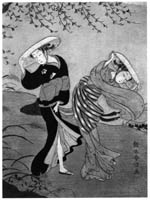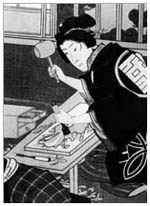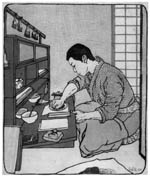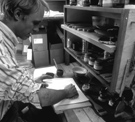Oil goes well with metal machinery, such as a printing press. Water goes well with living things that depend on water, like wood, and our own bodies. So printing with water works best done by hand, using a baren.The use of water as a medium in art and writing, and a tradition of the disciplined use of the human body in the production of craft, may have a lot to do with why Japan hosts a strong tradition of printing with water.
 |
 |
 |
|||
|
|
|
I have been working the craft of color woodblock print-making since January, 1993. Years spent working in the building trades after college (particularly cabinet-making) contributed a lot to the development of my printmaking. Self-taught in my printmaking, my pursuit in the first few years was mostly in isolation. Being able to spend time with Japanese prints, at home, with friends and neighbors who own prints, at museums, through books, has been very helpful. In my craft I feel grateful to the work and discoveries of generations of artists and craftsmen, many Japanese but not all. Finding Walter Phillips' book Technique of the Colour Woodcut was particularly helpful.
My friend John Lehet, who has helped me for years in building and maintaining my web-site, is a wonderful photographer and admirer of Japanese prints. He some time ago posted a nice description of his relationship with these prints on his own web-site. John wrote:
"I’ve been spending time looking at Ukiyo-e prints. Ukiyo-e means “floating world,” and everyone knows at least one of these images: Hokusai’s Great Wave. Maybe we know a few more Hokusai images or Hiroshige’s, or any number of the countless fantastic prints still available for viewing in museums, galleries and private collections. Also reproductions are available, and now with the magic of the indra-net, we can see thousands of them.
Taking time to cool down and look through Ukiyo-e images has been a beautiful thing this week, and they float in my mind through the day and as I lay down to sleep and wake up.
It’s funny, even back when I only made black and white prints, many of the compositional techniques from this genre appealed to me — and even before I saw very many of these prints. Really, so many elements of the genre have permeated my work all along before I even knew much about it: the heartbreaking beauty, the transience, incongruity and tension between elements, and a dynamic tension in the composition. There is a quality of image-as-poem that I’ve always aspired to."

